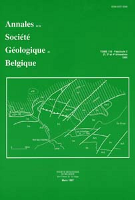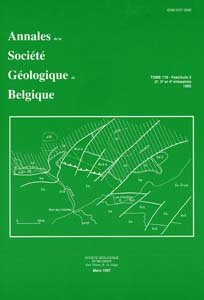- Accueil
- Volume 115 (1992)
- Fascicule 2 - Devonian-Carboniferous boundary
- Strontium isotopes in conodonts : Devonian-Carboniferous transition, the northern Rhenish Slate Mountains, Germany
Visualisation(s): 1301 (4 ULiège)
Téléchargement(s): 2256 (28 ULiège)
Strontium isotopes in conodonts : Devonian-Carboniferous transition, the northern Rhenish Slate Mountains, Germany

Abstract
A set of 51 87Sr/86Sr isotope measurements on biostratigraphically dated conodonts and brachiopods from the Devonian-Carboniferous transition of the northern Rhenish Slate Mountains yields a high resolution record for the 87Sr/86Sr isotope curve. The sections Hasselbachtal, Oberrödinghausen, Öse and Riescheid at the Remscheid-Altena Anticline were selected because of their excellent stratigraphic control and a low degree of diagenesis. However, trace element studies and XRD analysis show that the francolite of conodonts, an unstable end-member in the system francolite-fluorapatite, is prone to diagenetic alteration. 87Sr/86Sr of unaltered low Mg calcite of contemporaneous brachiopods corroborate a distinct enrichment in radiogenic 87Sr in the conodonts. The discussed 87Sr/86Sr curve is therefore a secondary curve that nevertheless preserves to some degree the pattern of the original Sr paleo-seawater curve. The pattern of 3rd-order isotopic variations reaches its radiogenic maximum near the Devonian-Carboniferous boundary, coincident with a regression maximum. The biostratigraphic correlation of the sections Hasselbachtal, Oberrödinghausen and Öse is confirmed by 87Sr/86Sr isotope stratigraphy. New conodont data show that the praesulcata Zone can be recognized in the Wocklum Limestone at the Oberrödinghausen and Hasselbachtal sections.
Zusammenfassung
51 87Sr/86Sr Isotopen-Messungen an biostratigraphisch datierten Conodonten sowie Brachiopoden des Devon-Karbon Grenzintervalls aus dem nördlichen Rechtsreinischen Schiefergebirges führen zu einer hochauflösenden Dokumentation der Sr-Isotopenkurve. Ausgewählt wurden wegen ihrer exzellenten stratigraphischen Bearbeitung und des niedrigen Diagenesegrades der Conodonten Profile am Remscheid-Altena Sattel : Hasselbachtal, Oberrödinghausen, Öse und Riescheid. Spurenelementanalysen und Röntgendiffraktometer-Untersuchungen zeigen allerdings, dass der Conodonten-Frankolith als instabiles Endglied des Systems Frankolith-Fluorapatit diagenetisch verändert ist. 87Sr/86Sr Vergleichsmessungen an nicht alterierten Brachiopodenschalen belegen eine radiogene Verschiebung der Conodonten. Diese 87Sr/86Sr Isotopenkurve ist deswegen eine sekundäre Kurve, bei der die Struktur der primären Sr Isotopen Palaeomeerwasser Kurve bis zu einem gewissen Grad bewahrt geblieben ist. Der Umschlagpunkt des übergeordneten Trends der dritten Isotopen Hierarchie fällt mit dem Regressionsmaximum an der Devon/Karbon-Grenze zusammen. Die regionale, biostratigraphische Korrelation wird durch gleiche 87Sr/86Sr Isotopenwerte bestätigt. Neue Conodonten Daten zeigen, dass die Zonierung mit Siphonodella praesulcata im Wocklum Kalk bei Oberrödinghausen und im Hasselbachtal anwendbar ist.






